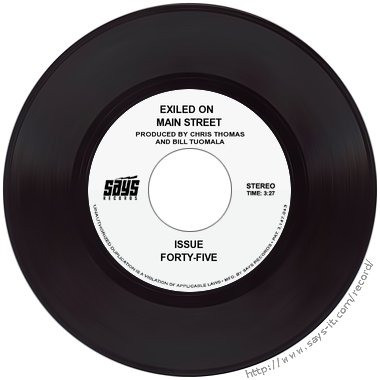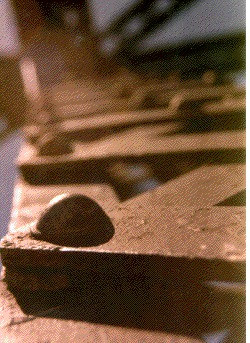Copy Link
Add to Bookmark
Report
HOMEBREW Digest #2855

HOMEBREW Digest #2855 Wed 21 October 1998
FORUM ON BEER, HOMEBREWING, AND RELATED ISSUES
Digest Janitor: janitor@hbd.org
Many thanks to the Observer & Eccentric Newspapers of
Livonia, Michigan for sponsoring the Homebrew Digest.
URL: http://www.oeonline.com
Contents:
Copper manifold in mash tun (Bob Fesmire dgofus@aol.com) (DGofus)
Suggestions for visits in Newark area? (Mike Beatty)
Re: All Munich (Steve Jackson)
Ginger (Dave Johnson)
Stuck fridgeration - IMFR? (MICHAEL WILLIAM MACEYKA)
Competition Announcement (again!)-- Spooky Brew Review (Andrew Ager)
Andrews acidic well water ("silent bob")
-ator... (Badger Roullett)
No Aroma Hopback ("Timothy M. Dugan")
Thoughts on re-using yeast/Dry-hopping in a keg ("Riedel, Dave")
RE: More on Bad Gas (Troy Hager)
Low gravity partial mash (michael w bardallis)
Grain depth and yield (ThomasM923)
Small scale malting (Ian Lyons)
Color Patches (AJ)
How To Use pH Strips? ("Randy Erickson")
Phosphoric acid vs lactic acid (ThomasM923)
Beer is our obsession and we're late for therapy!
Send your entries in for Hoppiest Event On Earth yet?
Details: http://members.tripod.com/~BrewMiester_2/Home.html
NOTE NEW HOMEBREW ADDRESS: hbd.org
Send articles for __publication_only__ to post@hbd.org
(Articles are published in the order they are received.)
If your e-mail account is being deleted, please unsubscribe first!!
To SUBSCRIBE or UNSUBSCRIBE send an e-mail message with the word
"subscribe" or "unsubscribe" to request@hbd.org.
**SUBSCRIBE AND UNSUBSCRIBE REQUESTS MUST BE SENT FROM THE E-MAIL
**ACCOUNT YOU WISH TO HAVE SUBSCRIBED OR UNSUBSCRIBED!!!
IF YOU HAVE SPAM-PROOFED your e-mail address, the autoresponder and
the SUBSCRIBE/UNSUBSCRIBE commands will fail!
For "Cat's Meow" information, send mail to brewery@hbd.org
Homebrew Digest Information on the Web: http://hbd.org
Requests for back issues will be ignored. Back issues are available via:
Anonymous ftp from...
ftp://hbd.org/pub/hbd/digests
ftp://ftp.stanford.edu/pub/clubs/homebrew/beer
AFS users can find it under...
/afs/ir.stanford.edu/ftp/pub/clubs/homebrew/beer
JANITORS on duty: Pat Babcock and Karl Lutzen (janitor@hbd.org)
----------------------------------------------------------------------
Date: Tue, 20 Oct 1998 06:53:12 EDT
From: DGofus@aol.com
Subject: Copper manifold in mash tun (Bob Fesmire dgofus@aol.com)
I have converted a half keg to a mash tun. My problem is, my friend is
supposed to get me metal screen/perforated plate for a false bottom...but, he
recently broke his leg and can not get it done. With the brew season upon us,
and my first attempt at all grain brewing calling me, what alternative? I have
heard of and have seen a manifold type setup with copper pipe with slits cut
in it to serve as a "false bottom". I have a manifold built, all except the
slits, and it fits nicely in the bottom of the keg, but I need some advice. Is
this a practical system, will I have to worry about stuck runoffs? Will it
hold me over until my lame friend shows up?
Thanks in advance..private e-mail okay.
Bob Fesmire
Madman Brewery
Pottstown, Pa
Dgofus@aol.com
------------------------------
Date: Tue, 20 Oct 1998 07:31:20 +0000
From: Mike Beatty <mbeatty@ols.net>
Subject: Suggestions for visits in Newark area?
Hello all-
I am spending 3 days in the Newark area and I was wondering if anyone
could suggest some good microbreweries/brewpubs in the area - I would
prefer to stay out of NYC, but if that's the only place, I will probably
force myself to go...
Thanks!
- --
Mike Beatty
Intelligent Business Solutions
________________________________________________
Adopt a Collie! Check out: <http://www.collie.net/~pcc>
________________________________________________
Do you believe in Macintosh? <http://www.evangelist.macaddict.com/>
------------------------------
Date: Tue, 20 Oct 1998 06:28:24 -0700 (PDT)
From: Steve Jackson <stevejackson@rocketmail.com>
Subject: Re: All Munich
In HBD #2854 (Oct. 20, 1998), David Root wrote:
>>>>
Our Club, the Niagara Assoc. of Homebrewers and I brewed
the All munich malt. 33 Pounds of grain, ~8 gals of water. 15 gals
of wort somewhere around 154 Df (it was an up and down ride)
Yes it converted, but only after four hours. OG 1.066. A great
time was had by all.
Thanks for the input.
<<<<
I'm curious as to the brand of Munich malt you used. I've never had
trouble converting German Munich malt, namely Durst in an all-Munich
mash (not that I've used it a ton of times, but the few times I've
used it, it converted fine), and I know of others who report the same
results. However, I do know of cases where people have attempted
all-Munich mashes using North American "Munich" malt and had the same
conversion problems you witnessed. It's only speculation, but it seems
that N.A. maltsters appear to be making their Munich as a specialty
malt to be used in small quantities, while Continental maltsters make
their Munich so that it can be used as a base malt.
-Steve in Indianapolis
_________________________________________________________
DO YOU YAHOO!?
Get your free @yahoo.com address at http://mail.yahoo.com
------------------------------
Date: Tue, 20 Oct 1998 10:37:24 -0400
From: Dave Johnson <djohnso@OPIE.BGSU.EDU>
Subject: Ginger
Greetings All,
I thought I'd chime in on the ginger thread since I've been using it
3-4 times a year for 4 years. My observations suggest it behaves
much like hops, not too surprising since they both contain volitile
oils. I use a total of 1 1/2 oz. of grated ginger in my Ginger wit
(6 gal.)......3/4 oz. for 5 min. and 3/4 oz. at flame out. I then send
EVERYTHING to the primary, hops, trub, orange peel, and spices
(yeah, yeah, yeah....but let me finish).
I and others think this provides a nice balance of aroma, flavor,
and a bit of the 'ginger burn' (which goes well in a wit, IMO).
I sent my last batch of this beer to the primary leaving all the
above behind in the boil tun. I think it turned out very substandard,
lacking in ginger aroma and the burn.
I've noted in the past that no burn survives if the all ginger is
boiled for 5+ min. and the burn and aroma are lost if boiled for 10+
min. I've also found that ginger aroma and burn start to fade in
bottles of my standard ginger wit around 2 mo.
I'm quite interested in the bottle addition of ginger that was
mention by John Munn. I think I will also experiment with a tea
prior to packaging. As always, this is but one non-scientific set
of observations and YMMV.
Cheers,
- --
Dave Johnson aka Tall Dave
------------------------------
Date: Tue, 20 Oct 1998 10:44:27 -0400 (EDT)
From: MICHAEL WILLIAM MACEYKA <mmaceyka@welchlink.welch.jhu.edu>
Subject: Stuck fridgeration - IMFR?
Howdy All,
Picked up an old, very old fridge from, uhm, counsel has advised
me I need not comment. Anyway, I cleaned it and plugged it in. Worked
fine for several days but an unpleasant aroma developed in the freezer
bin. I then recleaned it, re-hosed it down, moved it back into place
and waited a day. I plugged it back in and nothing. No sound no click
no nothing. All I know about electricity is that it makes things go and
it hurts. Oh, and v=ir. Any wisdom from the collective as to where to
start trying to get this thing working again?
Mike Maceyka,
Still accepting suggestions for cool brewery names and free fridges...
Baltimore, MD
------------------------------
Date: Tue, 20 Oct 1998 10:23:25 -0500
From: Andrew Ager <andrew-ager@nwu.edu>
Subject: Competition Announcement (again!)-- Spooky Brew Review
The Chicago Beer Society Presents:
Spooky Brew Review 1998
A BJCP Registered homebrew competition
October 31st, 1998 at Hopcats Brewing Company, Chicago, IL
Enter to win one (or more!) of our festive Halloween ribbons. They
certainly are unique! Prizes too! Simple entry forms, no full recipes
required!
Judges, sign up early for category preferences, as seats for this contest
fill up quickly.
Enter one of our special categories for only $1:
Smashed Pumpkin Award -- send us your absolute worst concoction for a
special ribbon. All entries must be drinkable!
Spooky Award -- use your imagination, come up with the scariest looking
beer for a special ribbon. Again, it must be drinkable!
Two bottles per entry, $6 for each entry, $5 each for 4 or more. Entries
accepted between October 17th and 24th.
See http://www.mcs.net/~shamburg/cbs/spooky98.html for complete details and
forms, or contact Ron Phillips at rmphilli@uic.edu or (708) 358-1603.
Andrew Ager Program Assistant, Webmaster
andrew-ager@nwu.edu School of Education and Social Policy
847/491-3790 (phone) Northwestern University
847/467-2495 (fax) http://www.sesp.nwu.edu/
------------------------------
Date: Tue, 20 Oct 1998 10:08:08 PDT
From: "silent bob" <holdenmcneil@hotmail.com>
Subject: Andrews acidic well water
Hello all,
I have been reading up on water treatment lately, as I am about to move
to an area with the opposite problem as Andrew has. Andrew describes
his water as being soft, but with a pH of 5.5-6. It is my understanding
that water of this low a pH is not only less pleasant to drink than
water of a pH of 7-7.5, but that it is not kind to pipes and fixtures.
For these reasons alone I would suggest further testing. For brewing
purposes, unless you are brewing pilsner, some treatment would be
recomended, but I would want to know the source of the acid first.
CaCO3 is a good choice to de-acidify this water (not knowing what the
acid is) since it will add needed calcium, and is a powerful buffer.
The low solubility for CaCO3 is in neutral water, CaCO3 is quite soluble
in acidic water as the following reaction occurs: CaCO3 + H+ --> Ca+,
OH-, CO2. You will even observe the CO2 bubbles when you add CaCO3 to
your water. The reaction is not reversible because of the dissipation
of CO2.
Good luck with this water, and try to find out the source of acid!!
Adam
______________________________________________________
Get Your Private, Free Email at http://www.hotmail.com
------------------------------
Date: Tue, 20 Oct 1998 10:22:14 -0700
From: Badger Roullett <branderr@microsoft.com>
Subject: -ator...
"1) It is a pungent-smelling lacrimator. (That means it'll bring tears to"
wow, what a cool name for a Salvator clone or knock off.. :)
***************************************************
Brander Roullett aka Badger
Homepage: http://www.nwlink.com/~badger
------------------------------
Date: Tue, 20 Oct 1998 13:35:59 -0500
From: "Timothy M. Dugan" <tdugan@netins.net>
Subject: No Aroma Hopback
I started using a hopback a couple batches ago to help keep the crap out
of my fermentors. And in this vein it has worked great.
In the process, the hopback has added a hop aroma to my beer that is
quite enjoyable.
Now I am getting ready to brew a Scottish Ale where any hop aroma would
be inappropriate. What do you hopback users do when you don't want the
hop aroma?
Do you use less hops? Do you skip the hopback? Or does anybody do what
I'm leaning towards...put the hopback after the chiller.
Your thoughts would be helpful.
Tim M. Dugan
------------------------------
Date: Tue, 20 Oct 1998 12:27:38 -0700
From: "Riedel, Dave" <RiedelD@PAC.DFO-MPO.GC.CA>
Subject: Thoughts on re-using yeast/Dry-hopping in a keg
I brewed a batch of APA on 20 Sept. On 12 October, I racked it to a
corny keg. I left the yeast cake with a few cups of beer in the bottom
of the primary and left it sitting at cool room temperature, say average
16-17C (61-63F). Normally, I'd transfer the slurry to a sanitized jar and
put it in the fridge. It's my understanding that a slurry will keep well,
if refridgerated, for 2 weeks. Do you think my yeast is still okay to use?
I suppose that the best thing to do would be to make a starter and taste
it, but if the consensus is "Yikes! Dump it!", then I won't bother trying.
A second question, I dry-hopped the above APA in the keg (30g
Willamette in a hop bag). The hop character is pretty intense after
1 week. If it's not going to mellow, I'd probably like to remove the
hops from the keg. The keg IS carbonated. Can I get the hops out
without making a huge mess?
-dave
Victoria, BC, Canada
------------------------------
Date: Wed, 21 Oct 1998 00:43:16 -0700
From: Troy Hager <thager@bsd.k12.ca.us>
Subject: RE: More on Bad Gas
HBDers,
Thanks for the quick and prolific responses. Most think I have a
cleaning/sanitizing problem, but I don't think that is the case. I am very
careful about cleaning and sanitizing and will clarify what I do in that
area:
First of all, I have replaced all of the seals and o-rings in the system.
After emptying the last batch out of the keg, I rinse it out with cold
water (as Fix tells us to do) and then fill it with hot water from the tap
and add some TSP. I let it sit for a while and then with a sponge/green
scrubbie I rub down the inside. I then rinse very well. I also take the in
and out tubes and conections off and soak them in TSP and rinse as well. I
then soak everything in iodophor for about half an hour or longer. When I
am ready to keg I drain all of the iodophor and let drip upside down for a
bit.
I then assemble the sanitized parts and purge the keg with CO2. I push the
beer from the secondary keg into the final keg with gas. I put about 30psi
on it and roll it around a little, add more gas, more rolling, more gas and
then put it in the fridge for a couple days to carbonate.
When it's ready to tap, I disassemble the beer-out valve and my beer line
which I rinse and soak in iodophor. I even run a small bottle brush with
iodophor through the bulkhead fittings that come out of the fridge before
assembling the tap and beer line.
So, after all this, I still believe that I have an off-flavor in the
carbonated beer that I haven't tasted in the secondary. I don't think that
my cleaning/sanitizing is at fault. Could it be the gas???
-Troy
------------------------------
Date: Tue, 20 Oct 1998 18:20:09 -0400
From: dbgrowler@juno.com (michael w bardallis)
Subject: Low gravity partial mash
Mikey sez:
"I just brewed my first partial mash batch yesterday and the OG came
out a little lower than expected. The grain bill called for 3# of
malted barley and 3# of DME. When I measured the OG, it was 1.022.
That seems just more than a little low (the target OG was 1.038) The
reason probably has something to do with my sparging technique" etc
Mikey,
You're probably on the right track, looking at sparging. My first couple
of brews suffered the same fate. I found that restricting the flow of
runoff from the lauter tun (say, taking 20 minutes to drain it) brought
the extraction rate right up. If your kettle capacity permits, you could
probably safely sparge a bit more, too. And, of course, using more malt
next time is cheap-n-EZ....
Mikey
___________________________________________________________________
You don't need to buy Internet access to use free Internet e-mail.
Get completely free e-mail from Juno at http://www.juno.com
or call Juno at (800) 654-JUNO [654-5866]
------------------------------
Date: Tue, 20 Oct 1998 19:35:44 EDT
From: ThomasM923@aol.com
Subject: Grain depth and yield
I was wondering if anyone has realized a change in their yield after making a
change in the size or dimensons of their lauter tun? I have never been
convinced that the typical grain bed depth in a 5 gallon bucket (with 9-11
lbs. of grain) was the optimum depth. I was wondering if shallower grain bed
depths would give a better yield and perhaps a quicker overall sparge time.
Any opinions?
---Thomas Murray
------------------------------
Date: Wed, 21 Oct 1998 09:35:37 +0930 (CST)
From: Ian Lyons <ilyons@science.adelaide.edu.au>
Subject: Small scale malting
Ladies and gentlemen
I have found myself in the possession of 10kg of Triticale (a hybrid of
wheat and rye), and have been challenged to make a beer from it.
I decided to malt the grain rather than whimp out and use the diastatic
power of barley malt and gelatinised triticale.
My pilot malting has reached a technical difficulty: kilning is not
possible in my domestic oven, bcs even at the lowest setting the
temperature fluctuates dramatically between about 42 and 57oC.
Another option is to try to sun dry the grain, but it isn't too hot here
in South Australia yet!
Maybe the clothes tumble dryer on low heat?
Has anyone got any ideas as to how I might regulate the temperature of a
warm air flow to about 43-47oC (110-140oF?). Design constraints include
little cost: I'm not sure if this malting business is going to be a way
of life just yet.
Thanks
Ian Lyons
ilyons@biochem.adelaide.edu.au
------------------------------
Date: Tue, 20 Oct 1998 21:40:46 -0400
From: AJ <ajdel@mindspring.com>
Subject: Color Patches
John Slusher asked about beer color wheels and color patches. I, too,
have been unsuccessful in finding a color wheel, or, more particularly,
a manufacturer who would be willing to make one for me. Too bad because
I have in hand a visual color comparison device which sells for about
$25 which could, I believe, solve the problems with measurement of color
at least out to the Guiness stout level if I could get the color wheel
to go with it. In case anyone out there has an approriate connection,
what I need is a plastic wheel of about 4" diameter with an
approxiamately 2 cm wide strip of color running around the edge with
increasing density as one moves around the circle.
That being said, the Davison Color Guide, found in many home brew supply
catalogs, does exist. It consists of 10 small patches of color print
film. Individual batches apparently vary somewhat but the sample I
tested was labeled 3, 5, 6, 7, 8, 9, 11, 14, 17 and 19 Lovibond. As the
colors are set by relative levels of magenta, cyan and yellow dye in the
film the absorbtion spectra of the patches differ dramatically from
those of beer but the patches labeled 3, 5, and 6 are fair metamers of
beer colors (i.e. they look like beer colors). The patches labeled 7, 8,
11,17 an 14 are slightly worse in this regard and the darkest, 19 L, is
a poor approximation of beer color (it's not saturated enough for its
redness). This is not a problem as we judge beer "color" by its apparent
lightness or darkness. One of the big limitations of the SRM measurement
is that a beer which is visibly darker than another can have a lower SRM
value than the lighter appearing beer. These occasional exceptions aside
SRM (approximately equal to Lovibond) is very closely correlated with
luminance (the apparent lightness or darkness of the sample) and we can,
therefore, determine what the SRM color of the patches would be from
their measured luminances. We found the best agreement between the
patches' luminances and real beer luminances when we assumed the beer
path was 10 cm (4"). This is inconsistent with the instructions which
direct the user to pour no more than 1" of beer into the bottom of a
standard contest plastic cup and find the color patch which most closely
matches the beer. I believe these cups to be closer to 5 cm in diameter
near the bottom. Nevertheless, using the relationship between SRM and
luminance for a
10 cm path we found that the 6 L patch was in error by 1.8 SRM units the
11 and 17 patches by about1.5, the 15 L patch by 1.2 and the rest were
within one SRM unit or less. The instruction sheet claims the device
will give results to 2 L or better and we find that claim substantiated.
These little doodads are extremely handy for contests.
------------------------------
Date: Tue, 20 Oct 1998 20:26:32 -0700
From: "Randy Erickson" <RANDYE@mid.org>
Subject: How To Use pH Strips?
I recently bought some colorpHast strips (range 2 to 9) after
giving up on the cheap paper ones. I am attempting to solve
a problem with starchy, cloudy pale all-grain beers.
My water has a hardness value of 252 and an alkalinity of 154
(averages, as CaCO3). I don't have the analysis in front of me,
but as I recall the natural pH is around 8. I carbon filter this
water, but don't usually add any salts (except occasionally
gypsum for English ales).
In my most recent batch, I was able to get the sparge water pH
down to the proper range with lactic acid additions, but I gave
up on trying to read the mash pH with the paper strips (mash
color was too close to that of the paper).
The brief instructions on the package say "Dip in --- read while
still moist." Then "Immerse in weakly-buffered solutions
until there is no further color change (1-10 minutes)." These
two statements seem to contractdict each other --- do I just dip
and read, or do I have to wait several minutes?
If these strips work out okay, I plan to try acidifying the mash
with lactic acid also. Is this the right approach for this water
and pale worts?
Any advice would be appreciated,
Randy in Modesto
------------------------------
Date: Tue, 20 Oct 1998 23:36:08 EDT
From: ThomasM923@aol.com
Subject: Phosphoric acid vs lactic acid
I would like to further complicate things by bringing up something that I've
noticed about these two acids. If you make two samples of water equal in pH,
(let's say ~ 5.7pH) one acidified with lactic acid and one with phosphoric
acid, and heat them up to about 170 degrees F, in a little while the sample
acidified with lactid acid will become less acidic while the one acidified
with phosphoric acid will remain stable.
I'm sure others can explain this phenomenon, but what is most important is
what this can do to your beer. If you acidify your sparge water with lactic
acid to the proper pH and then heat it up to sparge temperature, you could end
up with water
that is outside the safe pH range as the heat breaks the lactid acid down.
- ---Thomas Murray
------------------------------
End of HOMEBREW Digest #2855, 10/21/98
*************************************
-------



















